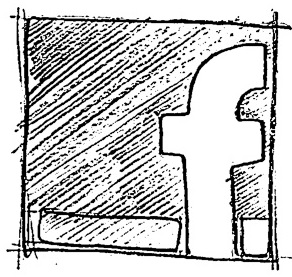by Ida Griesemer
On his site, Cetacean Nation Communications, Lieven Martens writes,
"My music is a landscape. A ku'ono for your mind to hike in. For the exploration of a personal jungle. For the atonement of a world out there, above there, in there. A spring of harmonies. A bay of sound. A natural and abstract composition, rooted in romance and subconsciousness."
Martens is a Belgian artist, based in Antwerp, who recently toured in the US with Monopoly Child Star Searches and Floris Vanhoof. Before his performance at Sarah Lawrence College on April 11th, we talked about his inspiration, process, sonic sources, and plans for… the future. Below is a picture of us ("You should be in it too - the interviewer is just as important," he said) and below that is our conversation.LL: Can you talk about your musical history; how long you've been with this project and projects you've done before that?
LM: I've been doing this since 2006 I think. Or 2007. That's under the name Dolphins Into the Future. But I've done similar stuff, but more deep manipulation, for I don't know, a bunch of years.
LL: More deep?
LM: Not more deep, but more… rusty. It was more just pure music. Dolphins into the Future is supposedly more centered through specific ideas and theories. It's not just music. It's more like a complete thing. The earlier stuff I did was just music; music of life.
LL: And your more recent stuff is informed by philosophy?
LM: Yeah. Theosophy. It's a movement that started in the mid-1800s. They do thesis of all the spiritual information in the world. She's called Blavatsky and she wrote a book called The Secret Doctrine. It's about, actually, just the past future and present of mankind. Mankind both in a physical way - like, we were born - but also in a ritual way. They use old pre-religious doctrine style writing. Pre-Christianity.
LL: As it relates to your music process, how do you bring in those writings?
LM: When I do an album - like I did an album called Music of Belief. Because I'm interested in how religious music is being created. You know, Buddhist music or even Christian music. For half a year I only read devotional texts. To see how that affects my brain, and what I make. And so that album sounds quite different from all my other stuff. But I have other albums. I made an album called Ke Ala Ke Kua. That's about the Kealakekua Bay in Hawaii, and all the things surrounding there. So it's not purely philosophical. It's one of the inspirations.
LL: What was it about that place that drew you to make an album about it?
LM: It's a heavy power stop for the Cetacean Nation. It just attracts a lot of activity around it. People who want to establish communication between man and dolphin. It's also just a place that looks like artwork from Caspar David Friedrich, the German painter. Just the colors and stuff and how it's all caved. I've been there. I did field recordings and camped there with a bunch of friends.
LL: Do you use your field recordings as your samples in your music?
LM: Yeah.
LL: Are all of your samples things that you've recorded?
LM: Mostly. Not all. But I started using them because I was interested in the musicality of - like when you record birds singing, instead of a surround-image it's a 2-D image. An aural image. And then if you listen to it, as a kind of music, there's a different, non-human, mathematic part to it. It's like classical musical done by an alien presence. A non-human presence.
LL: There's something mathematic to it?
LM: When you're a person and you write music it's mathematically like - you have octaves, or if you play certain notes and divide it, then it's another note… but birds their sound is a non-human mathematical sound. And it's just like listening to ocean waves, or birds, that affect me and how I start playing music. I try to create music that sounds more like it's coming from a non-human entity or whatever.
LL: Do you always start with some sort of sample from the natural world?
LM: A lot of times. Not necessarily always, but a lot of the time. I try to not overdo it, because when I look back through the last three years I've done music, it's been basically all filled with nature samples. I'm going to try to cut down a little bit on that. I mean, I don't want my music to sound like a formula or something. "Oh yeah it's that guy, with his ocean waves and eerie melody." I just think it's inspiring.
LL: So that's one of your aims for your next album is to move away from…
LM: I don't know. I'll just see what happens. It could be. But now I'm gonna go live in Portugal on these islands called The Azores and I'm going to record an album there. So I'm afraid it will be the same thing again, because it's surrounded by ocean and wildlife.
LL: Well it won't be the same thing…
LM: No, probably not. But definitely the latest compositions I made are purely only instruments. Not like the live show, because you will hear it's filled with that whole sound. Exaggeratedly.
LL: Your live show always is?
LM: No. For a while I didn't do it but now I'm more into it because a lot of times my live shows are disconnected from my LPs. So in this show I try to create almost the exact environment that I do on my records. Which is filled with animal sounds and water.
LL: Who is releasing your next record?
LM: There's a record with installation music I've made for the art of Ada Van Hoorebeke coming out with Aguirre in May. Beyond that I'm not sure. I have to be in the right mindset. Sometimes, for half a year I cannot make music. When you don't have ideas you cannot do it. Or at least have the strength to combine and finalize ideas.
To listen to a Dolphins Into The Future live set click here.





0 comments:
Post a Comment